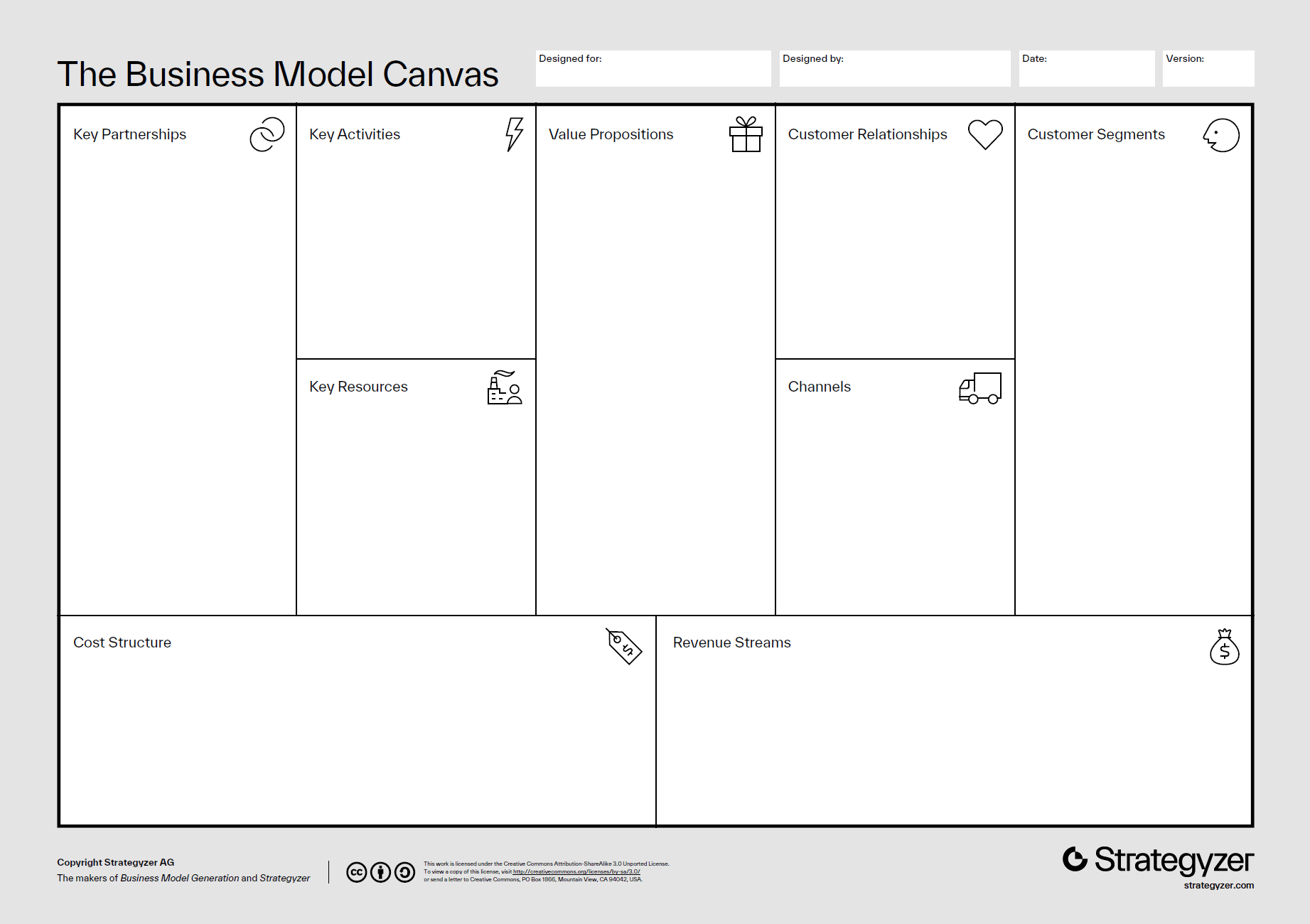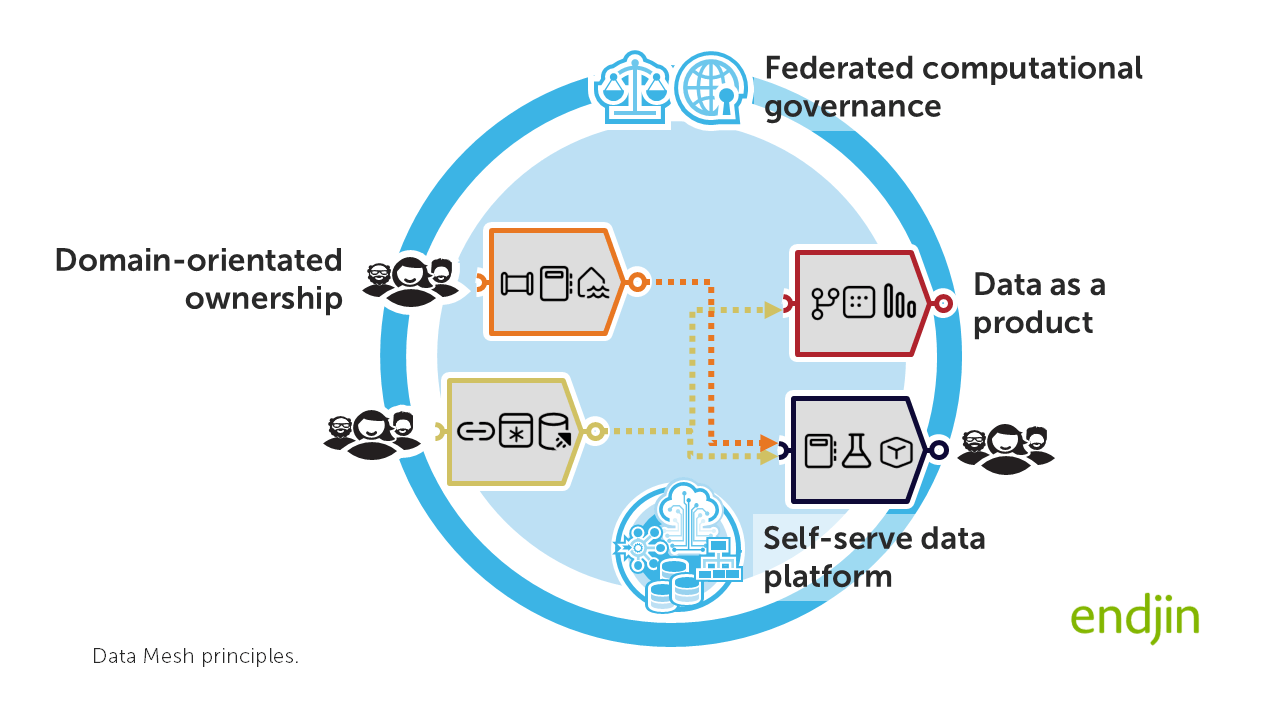The Data Product Canvas: The Theory Behind The Canvas

TLDR; The Data Product Canvas combines two powerful frameworks: the Business Model Canvas, which revolutionized strategic planning through visual collaboration, and Data Mesh, which reimagines data as a product. By understanding these theoretical foundations, you'll gain deeper insight into why the canvas works and how to apply it most effectively in your organization. This final part of our series examines the origins of these frameworks and how they've been synthesized into a practical tool for data product design.
In Part 1 of this series, we introduced the Data Product Canvas as a framework for designing data products that deliver real business value. Part 2 explored each of the nine building blocks in detail, and Part 3 showed the canvas in action through a worked example. Now, in this final instalment, we'll explore the theoretical foundations that make the canvas so effective.
Understanding the origins and principles behind the Data Product Canvas isn't just an academic exercise. By grasping the foundations, you'll be better equipped to:
- Adapt the canvas to your specific organisational context
- Explain its value to stakeholders and secure buy-in
- Apply its principles beyond the canvas itself to create a more product-centric data culture
- Recognize when and how to modify the approach as your data maturity evolves
Let's explore the two major frameworks that inspired the Data Product Canvas:
- Business Model Canvas - a visual tool for designing, exploring and iterating on new strategies and product ideas.
- Data Mesh - specifically the concept of "data as a product", which is one of the 4 key principles applied in a Data Mesh architecture.
Business Model Canvas
The Business Model Canvas (BMC) was developed by Alex Osterwalder and Yves Pigneur, with Osterwalder completing his PhD dissertation on business model ontology at the University of Lausanne in 2004. The formal publication came with their book Business Model Generation in 2010, which marked the canvas's widespread introduction to the business world.
The Business Model Canvas marked a paradigm shift in business planning. By converting complex strategic thinking into a visual, collaborative format, it democratized strategy development and moved organizations away from static, text-heavy business plans toward dynamic, testable business hypotheses.
I discovered it on a bookshelf in Waterstones in my home town. It immediately grabbed my attention as it was the first business strategy book I had come across which:
- Provided a visual alternative to traditional, text-heavy business plans.
- Seemed to make strategy development more accessible and collaborative, reducing the barrier to strategic thinking.
- Allowed organisations to quickly imagine, prototype and iterate business models on paper before committing large amount of resources to an idea. Allowing them to shift from traditional annual business planning to more dynamic, iterative approaches.
- Encouraged cross-functional collaboration in strategy development, in particular solving the "IT / business" divide.
- Facilitated easier communication of complex business strategies.
- Places the end-centred design at the heart of driving the design of new products and services.
It simplifies complex strategic thinking into nine fundamental building blocks:
- Customer Segments - the specific groups of people or organizations a business aims to serve and create value for.
- Value Proposition - the unique product or service that solves a customer problem or helps them to achieve a goal.
- Channels - the ways a company communicates with and delivers its value proposition to customers.
- Customer Relationships - the types of interactions and connections a business establishes and maintains with its customer segments.
- Revenue Streams - the various methods a company uses to generate income from its customer segments.
- Key Resources - the critical assets and resources required to deliver the value proposition effectively.
- Key Activities- the most important actions a company must perform to deliver its value proposition and operate successfully.
- Key Partnerships - the strategic relationships and networks that support and enhance the business model.
- Cost Structure - the total expenses associated with operating the business model across all its dimensions.
I first remember putting the Business Model Canvas into use in 2009 at ScottishPower. We used it to explore the future of customer experience within their Energy Networks business. It helped bring together a multi-disciplinary team that included the head of customer services, other members from her department, six sigma black belts and technology professionals. In the space of two hours we used a whiteboard version of the canvas and post-it notes to build situational awareness and explore possible strategies. It allowed us to develop a shared understanding, a common language for describing the challenges / opportunities ahead and clarity of purpose that we could all get behind. An immediate success!
I went onto use it in other roles. In one other notable case, it was used to help stakeholders in a 100 year old financial services firm understand how other organisations had successfully adopted new "digitally enabled" business models to disrupt their respective industries, diversify and sustain their business over the long term. We met on a monthly basis and used the Business Model Canvas to explore different case studies. It was "the thing that helped to get us to the thing" - in this case "the thing" being a deeper understanding how technology and data could be a force for good when it came to sustaining the firm for a further 100 years.
I wasn't alone. The tool was adopted by organisations of all shapes and sizes: corporations, non-profits, and government organisations. A global community of practitioners emerged, it was widely adopted in business schools and entrepreneurship programs and Strategyzer (Osterwalder's company) became a global force in advising companies on business model innovation.
In 2019, following a "career reboot," I have been emersed in the world of data and AI. I had thought I would no longer need Business Model Canvas until I came across Data Mesh.
Data Mesh
Data Mesh was first conceived by Zhamak Dehghani in 2018 while working as a principal technology consultant at ThoughtWorks. Dehghani developed the concept as a response to the limitations of traditional centralized data architecture approaches, particularly in large, complex organizations.
While Data Mesh is often discussed primarily as an architectural approach, its most transformative aspect may be its recognition that data is fundamentally a socio-technical challenge. By treating data as a product with internal customers, it shifts the focus from technical implementation to value delivery.
Fundamentally, Data Mesh is a socio-technical approach to data management that treats data as a product. It challenges traditional centralized data warehouse models by promoting decentralized domain-oriented ownership, self-serve data infrastructure, and policy as code.
The recognition that "data is a socio-technical endeavour" and the principle of "data as a product" in particular really appealed to me. It is aligned with the way that endjin have been approaching the delivery of data and analytics for the last decade. Largely I believe due to both Zhamak Dehghani and all of us at endjin coming from a software engineering background.
It recognizes that people are fundamental to success. If there are any issues with the people-related aspects, it will fundamentally undermine the overall success of that investment by impeding the flow of value, the understanding of end user needs, and the willingness of end users to adopt the solution, put it into use, and generate value from it.
By adopting a product mindset, data teams start to "think like entrepreneurs," adopting a proactive approach to delivering value while also accepting the responsibility for resource-allocation decisions by creating a clear link between data products, business value, and total cost of ownership (TCO), balancing inputs and outputs accordingly.
To succeed, these teams need to develop new tools to help them iterate on ideas to define what a "data product" actually is, and what's required to discover, build, and own a successful data product.
One such tool is a version of the Business Model Canvas that we have adapted for Data Products.
Data Product Canvas = Business Model Canvas + Data Mesh
The Data Product Canvas is a version of the Business Model Canvas adapted for iteratively envisaging and evaluating ideas for data products. We've renamed the 9 building blocks to better reflect the specific context of data products:
- Customer Segments ➡️ Audience - the specific groups of people that the data product is aiming to create value for.
- Value Proposition ➡️ Actionable Insight - the data driven actionable intelligence that will be delivered by the data product to allow the audience to achieve a specific goal.
- Channels ➡️ Consumption - the means through which the audience will access and use the data product.
- Customer Relationships ➡️ Adoption - the support that will given to the audience to enable them to successfully discover and use the data product.
- Revenue Streams ➡️ Lifetime Value - the value (tangible and intangible) that the data product is aiming to deliver over its lifetime.
- Key Resources ➡️ Data Skills, Tools and Methods - the key capabilities that will be required to deliver and sustain the data product over its lifetime.
- Key Activities ➡️ Data Processing - the actions that will need to be performed to transform data sources into the actionable insight.
- Key Partnerships ➡️ Data Sources - the data sources which are required to deliver the actionable insight.
- Cost Structure ➡️ Total Cost of Ownership - the projected costs to design, build, test, operate, maintain and evolve the data product over its lifetime.
Why This Combination Works
The synthesis of these two frameworks creates something greater than the sum of its parts. Here's why this combination is so powerful:
From the Business Model Canvas:
- Visual collaboration: The canvas format facilitates cross-functional discussions and breaks down silos between business and technical stakeholders.
- Holistic thinking: The nine-block structure ensures teams consider all critical aspects of a successful product, not just the technical implementation.
- Rapid iteration: The format encourages teams to quickly explore, validate, and refine ideas before committing significant resources.
- Strategic alignment: By making value explicit, the canvas ensures data initiatives support broader business objectives.
From Data Mesh:
- Product mindset: Treating data as a product shifts focus from technical implementation to user value and adoption.
- Socio-technical approach: Recognition that successful data initiatives require addressing both human and technical aspects.
- Domain orientation: Focusing on specific business domains rather than trying to solve all data problems at once.
- Value accountability: Making teams responsible for both the costs and benefits of their data products.
The canvas works even if you're not implementing Data Mesh as an architecture. The product-thinking principles it embodies are valuable regardless of your technical approach to data.
Beyond the Framework: Building a Data Product Culture
While the Data Product Canvas is a powerful tool, its greatest value may be in how it shifts organizational thinking about data. By applying the canvas consistently, organizations begin to develop:
- Purpose-driven development: Moving from technology-first to purpose-first thinking
- User-centered design: Deeply understanding who will use data products and how
- Value measurement: Quantifying and tracking the actual business impact of data initiatives
- Lifecycle management: Considering the entire data product lifecycle, from inception to eventual retirement
- Sustainable resourcing: Making explicit decisions about ongoing investment based on realized value
This culture shift is often more transformative than any specific data product that emerges from using the canvas.
Conclusion
The Data Product Canvas represents a powerful synthesis of business model thinking and data product principles. By combining the visual collaboration and holistic thinking of the Business Model Canvas with the product mindset and socio-technical approach of Data Mesh, we've created a practical tool that helps organizations overcome the most common causes of data product failure.
Throughout this four-part series, we've:
- Introduced the canvas and explained why traditional approaches to data products often fail
- Explored each building block in detail with practical guidance
- Demonstrated the canvas in action through a real-world scenario
- Examined the theoretical foundations that make the canvas effective
The Data Product Canvas isn't just another framework to follow. It's a catalyst for a fundamentally different approach to data initiatives—one that starts with purpose, focuses relentlessly on user needs, quantifies value, and considers implementation realities. By adopting this approach, organizations can dramatically improve their success rate with data products and build a sustainable competitive advantage through data.
Whether you're just beginning your data journey or looking to improve the impact of an established data practice, the canvas provides a structured, collaborative way to ensure your data investments deliver real business value. We encourage you to download the canvas, adapt it to your needs, and use it to transform how your organization approaches data products.
The journey to becoming truly data-driven isn't about technology—it's about purposefully creating products that help people make better decisions and take more effective actions. The Data Product Canvas is your guide on that journey.
If you would like an Adobe Acrobat version of the canvas, please reach out to us.







